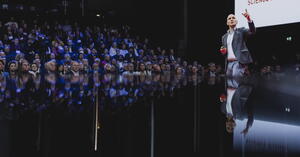Which walls remain?
It is a grey November morning in Berlin as the taxi passes the Brandenburg Gate. Heavy construction works are underway all around the emblematic monument, and on the boulevard Unter den Linden, as the German capital prepares to commemorate both one of the darkest and one of the brightest moments in its history. Fifty-one years after horrific Kristallnacht anti-semitic pograms in 1938, the wall that had divided East from West Berlin fell on 9 November 1989.
Now, every year since 2009, November in Berlin is a time for asking “Which are the next walls to fall?” The Falling Walls Science Summit brings together global science leaders, business pioneers, and public sector visionaries “to share knowledge, foster collaboration, and shape the future of the international innovation system—creating meaningful impact for humanity.”
For ITER, the Summit in Berlin on 7 to 9 November was the second time on stage. Already at the first edition in 2009, former ITER Principal Deputy Director-General Norbert Holtkamp had introduced the ITER project, its goals and its genesis during the Cold War as a project promoting fusion energy for peaceful purposes.
Last Friday, Holtkamp took to the moderator’s chair to discuss which walls remain to fall to bring fusion energy to the industrial stage. His guests: ITER Director-General Pietro Barabaschi; Kimberly Budil, Director of the Lawrence Livermore National Laboratory; and Constantin Häfner, Managing Director at the Fraunhofer Institute for Laser Technology. “Developing nuclear fusion is a mission for mankind,” stressed Holtkamp. “Nuclear fusion could transform energy production, ensuring security and driving economic growth while supporting sustainability for future generations.”
Recent years have indeed seen remarkable progress for fusion technology, both in private and public R&D projects. But completely breaking down the walls to fusion commercialization will take more, the panel concluded. Technological, funding and human resource challenges remain. “At the end of the day we have to admit that it will take time,” said Häfner. “There is still a lot to do.”


